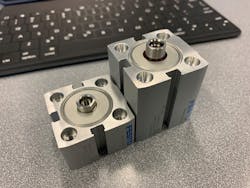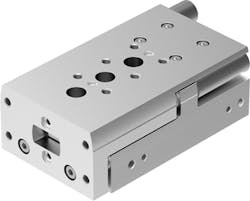Festo’s Pneumatic Essentials Program: Engineering the Future
VIDEO: Re-Engineering the Supply Chain
Changes in the way component parts are manufactured and distributed have addressed supply chain issues as well as design issues. Festo, for example, has launched its Pneumatic Essentials program. The goal is to streamline orders, ensure fast delivery of guaranteed in-stock components, and produce more compact parts for smaller footprints and energy efficient machines. Festo identified 16 fundamental pneumatic components within the Festo line that fit most common pneumatic applications, such as air preparation, eyewear, polyurethane tubing, one-way flow control valves, high flow valves and others.
Todd Shannon, the business development leader for the Essentials program at Festo, discussed the program and how it impacted Festo as both a manufacturer and as a supplier with Bob Vavra, senior content director for Machine Design. The interview has been edited for length and clarity.
Machine Design: The Pneumatic Essentials program looks at two issues facing machine builders—supply chain, and speed to market. Let's talk about the design part first. What are your customers coming to you today as they look to either expand manufacturing lines or improve their existing systems?
Todd Shannon: Our customers in the marketplace today are really looking at three areas, the first being a smaller footprint. I think with real estate being at a premium, all of our customer base is trying to get to a smaller machine to make all of our components smaller, to fit into the smaller footprint that the marketplace is commanding.
They want the products to be lightweight. There’s a lot more action taking place on the end of the robot arm, for instance. So, if we can reduce the weight, that takes the load off of the robot’s arm. Lightweight has become increasingly important, and then not to neglect scalability. A lot of our customers want to be able to add on or take away from their machine and do it and do it quickly and efficiently.
And with batch production, I don't think we’re going to see scalability go away anytime soon. So those are really three areas that our customers are focused on that we try to meet their needs.MD: It looks a lot like LEGO blocks: The individual components are really pretty simple and fundamental, but what you can build with them is really complex. But that takes engineering at the front end. Let’s talk about how your team approached engineering and, in some cases, re-engineering some of these component parts in order to achieve all those goals you just talked about.
TS: In 2017, we realized that we really wanted to focus on the field-level part of pneumatics. Historically, Festo’s been a market leader up in the higher end—the higher-tech products—and we still have our eye on that ball, but we wanted to focus down at the field level on some of these component-type items.
We figured out what products needed to be in this portfolio and after studying the marketplace, we decided that there was a common thread that ran through about 85% of basic pneumatic applications. After we identified those types of products, we looked at what we currently had. And to get this portfolio completed, we took a two-pronged approach.
The first was, we were able to take some of our existing products and make small design changes, but still keep that quality, that standard behind the Festo name, but really improve our cycle times in manufacturing. We took existing products and made a design change. And then we also just built brand new products from the ground up. And I’ll use our DGST precision slide and our SDBT—which is a new programmable auto switch—as examples.
So those are two new products that we built from the ground up to meet these demands from about 85% of the customers’ applications out there. Those pieces and identifying what's common in most pneumatic operations is really valuable both for the end-user and for the machine designer. It’s got to be a system that is robust enough to do all the things you wanted to do, but still gives you the flexibility of being able to make changes or to replicate those systems pretty quickly.
When Festo launched it, it is a global initiative; it’s not just the United States or North America. This is taking place all over the globe. All the part numbering system is going to be the same, whether it’s here or overseas. The commitment to stock locally, wherever you are on the globe, and then to be price-competitive.
MD: Then in the middle of all of this process came COVID. And then beyond that came supply chain issues. And that’s something we’ve been writing about a great deal. And one of the things that was noted as Festo launched Pneumatic Essentials was the availability of the products. But Festo’s also a manufacturer, they’re not just a supplier, so this meant changing your own manufacturing process. Can you talk a little bit about that?
TS: We’ve made a huge investment in our manufacturing, both in capital as well as Festo know-how, our automation expertise, to develop these lines with high cycle times. Just as an example, the precision slide table, the DGST—we can make one of those every 52 sec. Our guided rod cylinder, we can make one every 60 sec. and our standalone valves come out at one every 5 sec.
So we made this large investment in the throughput machinery to design, manufacture and build at a very high rate, but that was only part of it. It does us no good or our customer base no good if we can make these products at a high rate but not get them to the market. So we also invested in infrastructure, and just using North America and the United States as an example, we moved our manufacturing, —or our distribution center—out to Mason, Ohio, sort of centrally located in the United States. We quickly ran out of room there and we've already expanded, but we continue to make that commitment, build our logistics up so we can service all of our customer base.
MD: It’s a really interesting time in [the] supply chain because it’s finding that balance between you not wanting to carry too many component parts, but also wanting to have plenty on hand for your machine builders and for your end-users. It seems like that’s been a change in the thought process for manufacturers who are suppliers to the industry to say, “We’ve got to be able to find this sweet spot.”
TS: Just throughout the supply chain issues that everybody is experiencing, the delivery reliability on our Essentials portfolio is near 100%. It’s an amazing percentage of what we’ve been able to hold on our delivery reliability to our customers around these products, specifically.
MD: Is that a challenge you see your end-users having to face? It’s not that simple for them to say, “I’ve always used these parts and I'm always going to be able to use them.” There have been supply chain disruptions at all corners of the manufacturing process. We’re still fighting our way out of that supply chain difficulty right now.
TS: Absolutely. And we have multiple projects that have developed from a competitor not being able to supply components to our customers. So, yeah, our customers are unfortunately in a bad spot sometimes and they have to look at other alternatives to make things work. So, you know, fortunately, we’ve been on the lower end of that, and we’ve benefited from that.
I think we’ll weather this storm and the Essentials has been a great program to steer our customers towards. We can tell them with confidence that yes, these products are in stock today and they will be two months from now because we’ve made this commitment to always have them in stock.
MD: We’ve been writing the idea of designing for manufacturability, not just for the design itself. We see this emphasis on developing full systems that have a great design, but they can also be maintained and optimized through data capture. Let’s talk about how the Essentials program helps create a smarter manufacturing environment.
TS: I think most of our customers, in whatever industry you look at today, they are all about data collection—just for their own sake, for preventative maintenance. It’s a very large portion of what we have to take into consideration when we’re helping our customers. You know, as I said earlier, these are field-level components, so they are out in the field doing all the work.
But of course, we need feedback from them, so they’re built and designed to work hand in hand with many of our other core products within the Festo range. We can get that data from actuators, from directional control valves and take it back over the fieldbus network to where it can be analyzed and stored in data access points as well.
MD: One of the real interesting things that I’ve seen over the last few years with companies like Festo and a lot of the others we see in the manufacturing space is that you’re not component suppliers as much anymore as you are consultants to help the end-users be able to find the parts that they need, find the parts that might be similar to what they’ve used in the past and, with some different engineering, make that work into their operation.
TS: I think that’s important, and that’s really where Festo differentiates themselves in an area against our competitors. We're all really from day one at Festo taught, trained to really be a consultant. We’re not going to naturally know, be an expert on every product, but the great thing about Festo is our network, and we have people that are experts in applications engineers and segment people that, really, that’s their daily talk.
Consulting has to be part of who we are, and we get better at it every day. We’re not going to know everything, like I said. But this is a great place where we can rely on our colleagues as well as our distribution channel partners to be consultant type sales.
About the Author

Bob Vavra
Editor Emeritus, Machine Design and Power & Motion
Bob Vavra is the former senior content director of Machine Design and Power & Motion.


